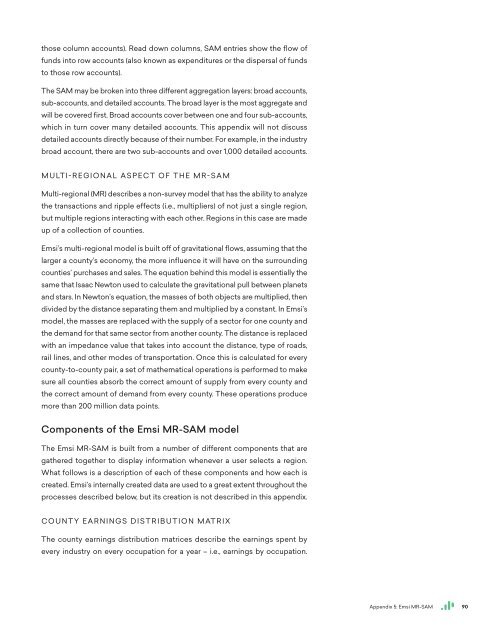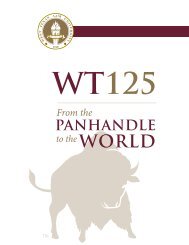The Economic Value of WTAMU Main Report
This report assesses the impact of West Texas A&M University (WTAMU) on the regional economy and the benefits generated by the university for students, taxpayers, and society. The results of this study show that WTAMU creates a positive net impact on the regional economy and generates a positive return on investment for students, taxpayers, and society.
This report assesses the impact of West Texas A&M University (WTAMU) on the regional economy and the benefits generated by the university for students, taxpayers, and society. The results of this study show that WTAMU creates a positive net impact on the regional economy and generates a positive return on investment for students, taxpayers, and society.
Create successful ePaper yourself
Turn your PDF publications into a flip-book with our unique Google optimized e-Paper software.
those column accounts). Read down columns, SAM entries show the flow <strong>of</strong><br />
funds into row accounts (also known as expenditures or the dispersal <strong>of</strong> funds<br />
to those row accounts).<br />
<strong>The</strong> SAM may be broken into three different aggregation layers: broad accounts,<br />
sub-accounts, and detailed accounts. <strong>The</strong> broad layer is the most aggregate and<br />
will be covered first. Broad accounts cover between one and four sub-accounts,<br />
which in turn cover many detailed accounts. This appendix will not discuss<br />
detailed accounts directly because <strong>of</strong> their number. For example, in the industry<br />
broad account, there are two sub-accounts and over 1,000 detailed accounts.<br />
MULTI-REGIONAL ASPECT OF THE MR-SAM<br />
Multi-regional (MR) describes a non-survey model that has the ability to analyze<br />
the transactions and ripple effects (i.e., multipliers) <strong>of</strong> not just a single region,<br />
but multiple regions interacting with each other. Regions in this case are made<br />
up <strong>of</strong> a collection <strong>of</strong> counties.<br />
Emsi’s multi-regional model is built <strong>of</strong>f <strong>of</strong> gravitational flows, assuming that the<br />
larger a county’s economy, the more influence it will have on the surrounding<br />
counties’ purchases and sales. <strong>The</strong> equation behind this model is essentially the<br />
same that Isaac Newton used to calculate the gravitational pull between planets<br />
and stars. In Newton’s equation, the masses <strong>of</strong> both objects are multiplied, then<br />
divided by the distance separating them and multiplied by a constant. In Emsi’s<br />
model, the masses are replaced with the supply <strong>of</strong> a sector for one county and<br />
the demand for that same sector from another county. <strong>The</strong> distance is replaced<br />
with an impedance value that takes into account the distance, type <strong>of</strong> roads,<br />
rail lines, and other modes <strong>of</strong> transportation. Once this is calculated for every<br />
county-to-county pair, a set <strong>of</strong> mathematical operations is performed to make<br />
sure all counties absorb the correct amount <strong>of</strong> supply from every county and<br />
the correct amount <strong>of</strong> demand from every county. <strong>The</strong>se operations produce<br />
more than 200 million data points.<br />
Components <strong>of</strong> the Emsi MR-SAM model<br />
<strong>The</strong> Emsi MR-SAM is built from a number <strong>of</strong> different components that are<br />
gathered together to display information whenever a user selects a region.<br />
What follows is a description <strong>of</strong> each <strong>of</strong> these components and how each is<br />
created. Emsi’s internally created data are used to a great extent throughout the<br />
processes described below, but its creation is not described in this appendix.<br />
COUNTY EARNINGS DISTRIBUTION MATRIX<br />
<strong>The</strong> county earnings distribution matrices describe the earnings spent by<br />
every industry on every occupation for a year – i.e., earnings by occupation.<br />
Appendix 5: Emsi MR-SAM<br />
90





